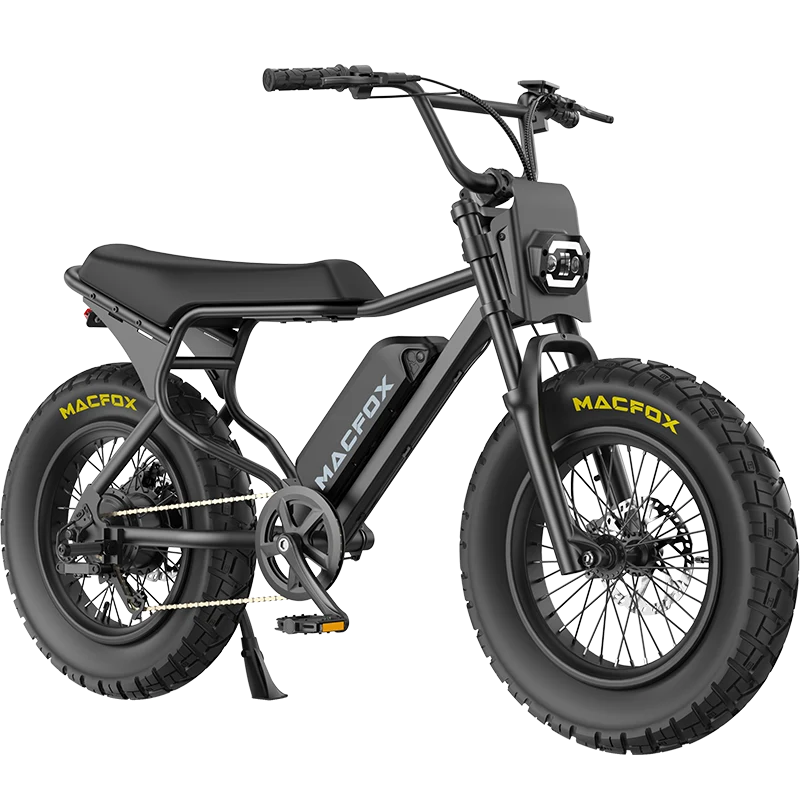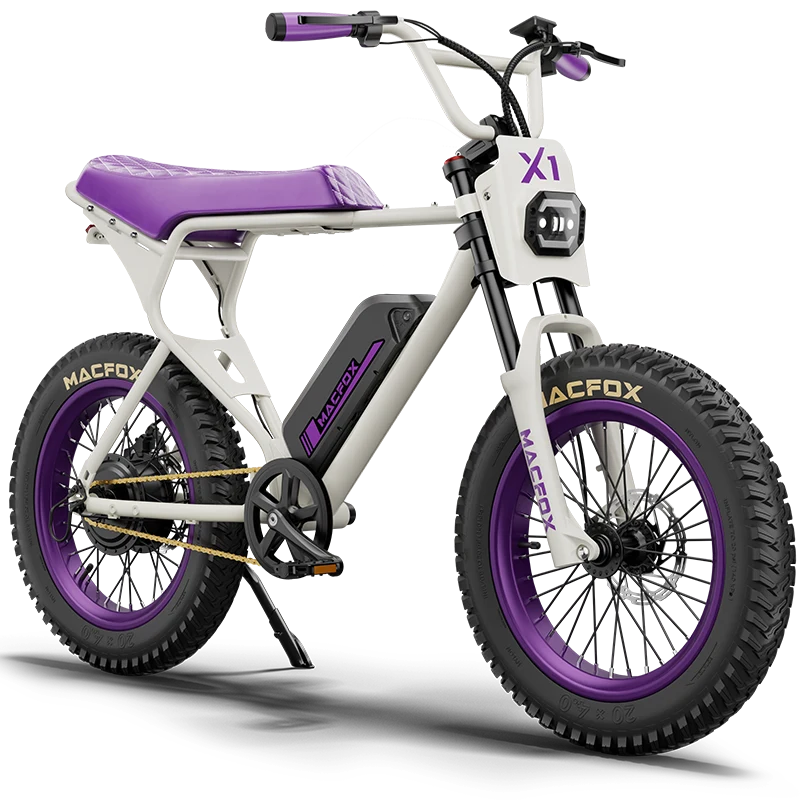Electric bicycles (e-bikes) have rapidly gained popularity due to their versatility and efficiency. For new riders, motor assistance simplifies climbing and reduces fatigue. For seasoned cyclists, it expands riding range and improves average speeds. Regardless of skill level, the motorized support of an e-bike adds value, enabling longer rides and greater exploration.
This article delves into the core technology of e-bike motors—how they operate, the various motor configurations available, and key technical specifications to consider. By gaining a deeper understanding of e-bike propulsion systems, you will be better equipped to select the ideal motor for your riding style and performance requirements.
The Core Component: The E-Bike Motor
At the heart of every electric bicycle is its motor. This device converts electrical energy from the battery into mechanical torque applied to the drivetrain or wheel, thus reducing the physical effort required by the rider. The motor does not operate in isolation; it works in tandem with a battery pack, sensors, and a controller (electronic control unit).
Key Supporting Components:
- Battery: Supplies DC electrical energy to the motor. Capacity (in Ampere-hours, Ah) and voltage (V) determine available range and power.
- Controller: Often considered the e-bike’s “brain,” it continuously monitors sensor input and regulates the current and voltage delivered to the motor.
- Sensors: High-quality e-bike systems rely on torque, cadence, and speed sensors. These provide real-time operational data, enabling the controller to deliver precise, natural-feeling assistance.
How E-Bike Motors Operate
Modern e-bike motors are typically brushless DC (BLDC) designs. Instead of mechanical brushes, they use electronic commutation for smooth, efficient operation. The motor’s stator—comprising windings—remains stationary, while the rotor, often containing permanent magnets, rotates. By sequentially energizing the stator coils with the controller’s signals, the rotor spins, delivering torque.
Sensor Integration:
Leading brands, such as Bosch, utilize multiple sensors capturing high-frequency data (often over 1,000 measurements per second). These inputs generally include:
- Torque Sensor: Measures how much force the rider applies to the pedals. More force results in higher motor assistance.
- Cadence Sensor: Detects pedaling speed (rotations per minute), ensuring the motor provides smooth, proportional support.
- Speed Sensor: Monitors wheel rotations via magnets on the spokes, enabling the controller to regulate assistance and adhere to legal speed limits (e.g., cutting off at 25 km/h in many regions).
This continuous feedback loop allows the motor to deliver consistent, rider-responsive assistance. It ensures efficiency, preserves battery life, and provides a natural, intuitive cycling experience.
Related Articles: Understanding Torque and Cadence Sensors
Key Technical Parameters

Voltage (V):
Voltage affects how quickly and forcefully the motor can respond. Higher voltage systems (e.g., 48V vs. 36V) can deliver higher torque and improved acceleration, making them well-suited for hilly terrain and heavier riders or cargo.
Ampere-Hours (Ah):
A battery’s capacity, measured in Ah, indicates how much energy it can store. More Ah generally translates into greater range. For instance, a 14Ah battery may support around 60 miles of mixed riding, while a 10Ah battery might only provide about 40 miles.
Torque (Nm):
Torque (Newton-meters) is the rotational force at the crank or wheel. Higher torque ratings yield stronger acceleration from a standstill and improved climbing ability. A motor rated at 75 Nm will outperform a 40 Nm motor when starting on steep grades.
Revolutions Per Minute (RPM):
RPM indicates how fast the motor’s output shaft spins. Higher RPM designs can maintain speed efficiently on flat terrain. Controllers often adapt motor RPM to match rider cadence for a seamless feel.
Power (W):
Wattage (W) derives from a combination of torque and rotational speed. A 500W motor typically handles steeper inclines and heavier loads better than a 250W unit. However, higher wattage can draw more current, potentially reducing range if not managed efficiently.
Related Articles: 250w vs 500w E-Bike Motors
Pedal Assist Systems (PAS)
Most e-bikes employ a Pedal Assist System, automatically engaging the motor as the rider pedals. Multiple assistance levels let riders fine-tune their experience—from subtle support to full power—while maintaining a natural cycling sensation. On high-quality systems, advanced algorithms integrate torque and cadence data to ensure that motor output matches rider effort in real-time.
Types of E-Bike Motors
E-bike motors differ in design and placement. Understanding these differences allows riders to select a configuration that aligns with their riding conditions and preferences.
Rear Hub Motors
Geared Hub Motors:
These hubs use planetary gear reduction to increase torque and reduce motor speed. The compact gearing allows a relatively small motor to deliver strong power, making geared hubs ideal for commuter ebikes or heavy cargo bikes. Their free-spinning mechanism reduces drag when the motor is off, but the internal gears will wear over time, requiring occasional maintenance.
Direct-Drive Hub Motors:
Direct-drive hubs rely on electromagnetic forces between stator windings and permanent magnets. With no internal gears, they operate almost silently and are highly durable. They achieve high top speeds smoothly and can incorporate regenerative braking. However, they are larger, heavier, and typically generate less torque at low speeds, making them better suited for flatter terrain and steady cruising.
Related Articles: Which Motor is Best for Your E-Bike? Hub vs. Mid-Drive
Mid-Drive Motors
Mid-drive motors integrate at the bike’s crankset, driving the chainring directly. This configuration centralizes mass, improving bike balance and handling. Because the motor leverages the bike’s existing gears, it can maintain optimal RPM and efficiency across varied terrain. This results in excellent hill-climbing performance and extended battery life. However, mid-drive systems can increase drivetrain wear and are typically more complex and expensive to service.
Front Hub Motors
Front hub motors are simpler and often more cost-effective. They create a front-wheel drive configuration. While installation and maintenance can be easier, the added weight in the front wheel may alter handling. Front drives are generally low to moderate power solutions, suitable for flat terrain and light commuting.
Comparing Hub and Mid-Drive Systems
- Geared Hub: High torque, good hill climbing, moderate complexity, slightly more maintenance than direct-drive.
- Direct-Drive Hub: Smooth, durable, quieter, suitable for higher speeds, but heavier and less torque-heavy at low speed.
- Mid-Drive: Excellent torque, superb handling, makes full use of bike gearing, but more complex and can place extra stress on the drivetrain.
Your choice depends on what you value most: hill-climbing capability, riding feel, maintenance simplicity, or cost.
Motor Placement Considerations
Front Wheel:
Easier to install and typically cost-effective. Good for casual city riding but can affect handling and is less common on performance-oriented e-bikes.
Mid-Drive:
Offers excellent handling, optimal torque, and efficient energy use. It feels most like a conventional bike, making it popular for premium commuter and mountain e-bikes.
Rear Wheel:
A common choice providing balanced aesthetics and higher torque output. Installation and service can be more involved, but these systems often deliver strong, responsive power.
Powering the Motor: The Controller and Battery
The controller modulates power delivery from the battery based on rider inputs (pedal effort, throttle position, selected assist level). High-quality controllers ensure smooth acceleration, intuitive response, and efficient current management—key factors in achieving both powerful performance and long battery life.
Motor Wattage and Efficiency:
Selecting a motor wattage that matches your riding style is critical. High-wattage motors can tackle challenging terrain and heavy loads but may drain the battery faster. Conversely, a moderate-wattage motor paired with a robust controller can still offer excellent hill-climbing capabilities with efficient energy use.
Leading E-Bike Motor Manufacturers
Quality and reliability are paramount. Industry leaders, including Shimano, Bosch, and Yamaha, have established reputations for producing high-performance, durable systems:
- Shimano: Known for the STEPS series, offering a range of compact, efficient mid-drives suitable for urban and off-road use.
- Bosch: Renowned for refinement, torque sensors, and intelligent software. Their Performance, Active, and Cargo lines address diverse riding scenarios.
- Yamaha: With decades of experience, Yamaha’s PW series delivers smooth, natural-feeling power and robust reliability.
When selecting an e-bike motor, choosing from reputable brands ensures consistent performance, warranty support, and spare parts availability.
Conclusion
The “perfect” e-bike motor depends on your individual needs—terrain, load, riding style, and budget. Mid-drive systems offer unparalleled efficiency and handling, while hub motors (geared or direct-drive) provide simpler solutions that excel in specific conditions. By understanding the technical parameters—torque, voltage, wattage, and placement—and evaluating trusted manufacturers, you can confidently select a motor system tailored to your cycling goals.
FAQs
What distinguishes a geared hub motor from a direct-drive hub motor?
Geared hub motors use internal gears to boost torque and improve hill-climbing, whereas direct-drive motors rely solely on electromagnetic interaction. Direct-drive units run quietly and are extremely durable but are heavier and less efficient at low speeds.
Why choose a mid-drive motor?
Mid-drive motors leverage the bike’s drivetrain, allowing for optimal RPM under varying conditions. They deliver excellent torque, improved handling, and superior efficiency, making them ideal for challenging terrain and technical riding.
How does motor wattage influence performance?
Higher wattage generally means more power for climbing and hauling, but also increased energy consumption. Choosing the right wattage involves balancing performance needs with desired range and overall efficiency.
By delving into the engineering principles behind e-bike motors, you gain the expertise to make informed decisions, ensuring every ride is optimized for performance, comfort, and enjoyment.


















